Axbridge Raw Water Treatment Works |

91.2% |
Whole Project Award
Project Team:
Client: Bristol Water Plc
Designer: Black
& Veatch
Contractor: Costain
The Project
Aim of the project was to provide a replacement plant for the treatment of raw river water pumped from the River Axe and discharged into the Cheddar Reservoir. The site was equipped with large settlement tanks for a temporary treatment plant, erected some years before for drought relief. In addition, over a kilometer of unsightly overland pipeline, laid along the footpath rim of the Cheddar reservoir, had to be moved and buried at the embankment base.
The objective was to remove all of the temporary plant and pipeline, and to build a new state-of-the-art treatment works to remove silt, chemicals and organic matter from the river water for discharge into the reservoir. The reservoir itself is normally spring-fed from the Mendip Hills and it was feared that the River Axe water, if not treated to a high standard, could introduce nitrates and other chemicals to the water, causing algae blooms and excessive weed growth.
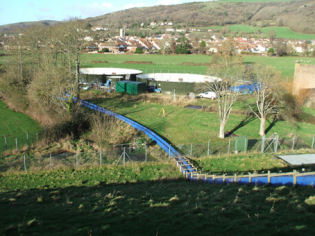 |
|
|
Recycling the old site
In early 2007, the existing tanks and pipe work were dismantled and stored for re-use at another site. The existing concrete base was re-used with little modification for the new treatment plant and actiflow units. The new plant was designed to fit onto the old concrete base, thus reducing the amount of demolition and materials required.
Building the Treatment Works
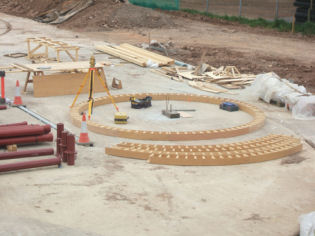 |
|
|
Formwork for the bases of the four actiflow units was added and erection of the off-site prefabricated structure began in May 2007. By June, the framework was taking shape. The dark green cladding of the building was specifically chosen to blend with its surroundings – a critical aspect for this site on the fringes of the Mendip Hills AONB. Extensive woodland planting was undertaken to provide additional screening for the new plant, as well as increasing the habitat for Biodiversity Action Plan Species – including bats.
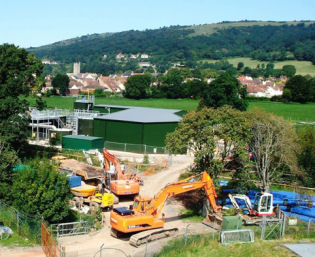 |
|
|
By August, construction of the building was complete and the task of connecting the plant could begin. The entire water treatment plant was completed in October 2007, several months ahead of schedule. A rigorous testing programme and training of the plant’s operational staff followed.
Innovative approaches taken
A number of innovative technologies were used to improve sustainability performance of the site. These included:
- For durability and low lifetime maintenance, stainless-steel pipe work was used in preference to coated materials.
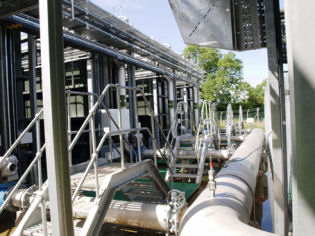 |
|
|
- Grasscrete roads were laid in preference to tarmac, thereby saving costs on additional drainage and omitting the need to obtain Environment Agency discharge consents.
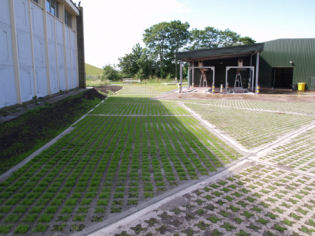 |
|
|
Community consultation
The repositioning of the pipeline along the rim path of the reservoir presented its own challenges, as the pathway around the reservoir has a high amenity value and is used by hundreds of walkers, bird watchers and anglers every week. For safety reasons, it had to be closed to the public for several weeks whilst the work was being completed.
Extensive consultation was undertaken with the local Axbridge Town Council and Cheddar Parish Council, and public exhibitions were held in both towns. Letter drops were made to local residents and the local angling club consulted. Large advance warning notices were erected at all entrances onto the rim path.
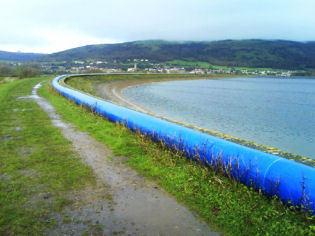 |
|
|
As a result of these efforts, not a single complaint was received from members of the public during the closure.
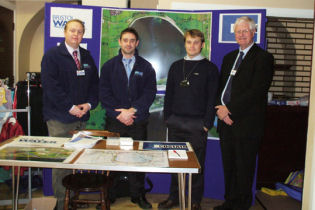 |
|
|
Relocating the pipeline
The removal of the overland pipe was a real feat of skill by the engineers. Originally it was proposed that the 1km pipe would be cut into small sections, lowered down the steep embankment and then re-jointed.
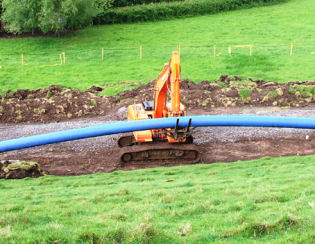 |
|
However, a method was devised using two large excavators, one at the top, with a sling attachment to lift it from the path and over the rim, and one at the base of the embankment, equipped with large forks to catch and reposition the pipe. This approach resulted in considerable savings in terms of manpower and costs for re-jointing the pipe. An additional pipeline was constructed alongside the repositioned pipe, thus providing a dual system to transport the raw water from the River Axe for treatment and taking the treated water from the new treatment plant to the discharge point into the Cheddar Reservoir.
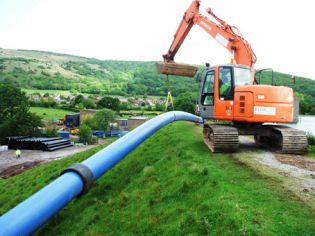 |
|
The opportunity was also taken to renew and refurbish the toe drainage system along the base of the reservoir embankment. The system had become damaged and blocked over the years, and now much of the adjacent pastureland had standing water or marshy conditions. The refurbishment has led to a real improvement to the area for grazing stock.
Looking after the environment and the community
The environment in which this project was undertaken had special significance for the way the contract was handled. The Cheddar Reservoir is a nationally important water for the over wintering of thousands of waterfowl. Large numbers of birds arrive in the autumn from the Somerset Level Wetlands and depart at the beginning of spring to breed on the hundreds of minor waterways that criss-cross the area.
Protection to these flocks is afforded by winter SSSI status for the reservoir. All of the work to remove the overland pipeline was scheduled for the period outside of the winter season. A small river traversing the site, the Ellenge Brook, was given special fencing protection within the compound area.
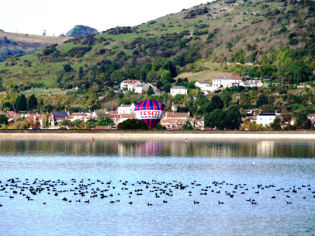 |
|
Along the route of the pipeline, leakage from the toe drainage had led to the development of marshland, and a large reed and sedge bed had grown on an area of around two acres, in what should have been good quality grazing land. There was a possibility that this wet area would cause damage to the reservoir embankment in future years.
Refurbishment of the toe drains cured the leakage problems. However, due to the SSSI restrictions on the reservoir, this work had to be done during the bird-breeding season and a winter inspection of the area had shown that, in previous seasons, some of the wildfowl had started to use the area to breed. The area was therefore hand-cut to ground level in late February, before the birds had moved off the reservoir, in order to dissuade them from nest-building on this site. The new drainage has now replaced a muddy swamp with lush pasture and a substantial increase of butterfly and other invertebrate insect life has been observed.
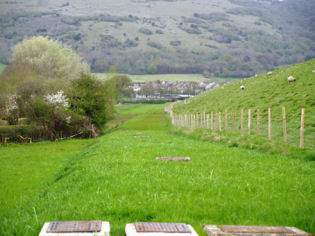 |
|
Working with the community
During construction, members of the town council were invited for an evening visit to the site, and the contractor and project client made a joint donation to the town’s Civic Trust to bedeck the town with hundreds of flowering plants and hanging baskets for their Britain-in-Bloom entry. Costain also provided a new surface to The Cheddar Angling Club’s car park near the reservoir, as a gesture of thanks for allowing part-use of the car park for material storage during the construction works.
Jim Ludkins of the Axbridge Town Trust receives a cheque from Andy Smith, Costain’s Liaison Manager and Paul Kelson from Bristol Water Corporate Affairs office.
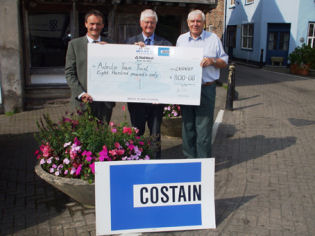 |
|
